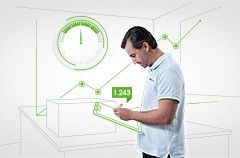
Handheld Density Meter
Fully Automatic Handheld Density Meter for the Lab or the Field
A handheld density meter is a portable device designed to measure the density of liquids in various industries, such as pharmaceuticals, food and beverages, chemicals, and more. Densito and DensitoPro by METTLER TOLEDO are two handheld density meters that offer convenience for both laboratory use and on-the-go measurements. They provide clear, step-by-step instructions to make measuring and cleaning easy, ensuring quality control from incoming goods to final products.
Advantages of METTLER TOLEDO’s Handheld Density Meters

Density Measurements Anywhere
The Densito’s bright color display achieves excellent visibility both indoors and outdoors. Multiple sequential measurements can be performed with ease thanks to the instrument’s lightweight and ergonomic design.

Measurements in Seconds
The result has an accuracy in density up to the third decimal place and is delivered instantly, allowing the user to quickly move on to the next sample. For additional security, measurement limits can be set for quick identification of results that are out of limits.

Automatic Sampling
The built-in sampling pump means that filling and emptying the measurement cell is performed completely automatically at the press of the joystick. Sampling speed can be adjusted to the task and sample at hand.

Enhanced Data Management
EasyDirect Software offers data management on a PC: results can be reviewed and filtered, and graphs can be created to monitor samples over time. Reports can also be printed from the software or directly from the instrument.

Cable Free Data Transmission
The DensitoPro comes with an RFID and barcode reader, allowing for a simple point-and-shoot sample ID entry. A cable-free Bluetooth printer allows for printing on the go (USA and Europe).

On Screen Instructions
A guided workflow can be created with predefined instructions in any language (EN, ZH, DE, ES, FR, IT, PT, RU, ID, KO, PL, TH, TR) which the operator can follow, confirming each step by pressing “OK”.
Explore Our Services - Tailored to Fit Your Equipment
We support and service your measurement equipment through its entire life-cycle, from installation to preventive maintenance and calibration to equipment repair.
Support & Repair

Training & Consulting

FAQs
What is the advantage of a digital handheld density meter vs. a pycnometer or an aerometer?
Digital handheld density meters offer several advantages over traditional methods like pycnometers or aerometers. For instance, our digital handheld density meter is both fast and accurate, delivering results within seconds and with an accuracy of 0.001 g/cm3. This high speed and measurement accuracy cannot always be achieved with traditional methods like pycnometers or aerometers.
Additionally, the digital density meter’s built-in electric sampling pump allows controlled sampling and rinsing at the press of a button, avoiding user-dependent sampling workflows.
Furthermore, our digital density meter supports digital workflows, allowing for easy sample entry using a barcode reader or RFID reader. Quality control is also made even more efficient with automatic pass/fail indication, and data can be exported directly to a printer or PC software. This reduces the likelihood of transcription errors that can occur when using manual methods and saves you valuable time.
Can a digital handheld density meter measure in other units than density and specific gravity?
While a digital handheld density meter is primarily designed to measure density or specific gravity, our digital handheld density meter has built-in conversion tables for Ethanol (Alcohol), Brix, API, Baumé, H2SO4, Plato, Proof (US and IP), and user-defined concentration. This allows users to convert the density or specific gravity readings into other units of measurement.
How does a digital handheld density meter handle samples with different temperatures?
Our digital handheld density meter offers built-in temperature compensation which allows you to measure the sample at any temperature between 0°C and 50°C (14°F to 122°F) and calculate the density at the required temperature (e.g., 20°).
All the conversion tables built into the device include temperature compensation. For any other samples, a temperature compensation factor can be entered. If you do not have this information, it can be automatically determined by measuring the sample at two different temperatures.






